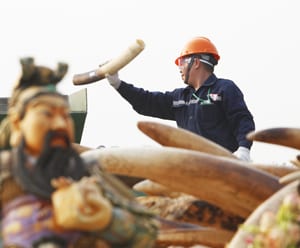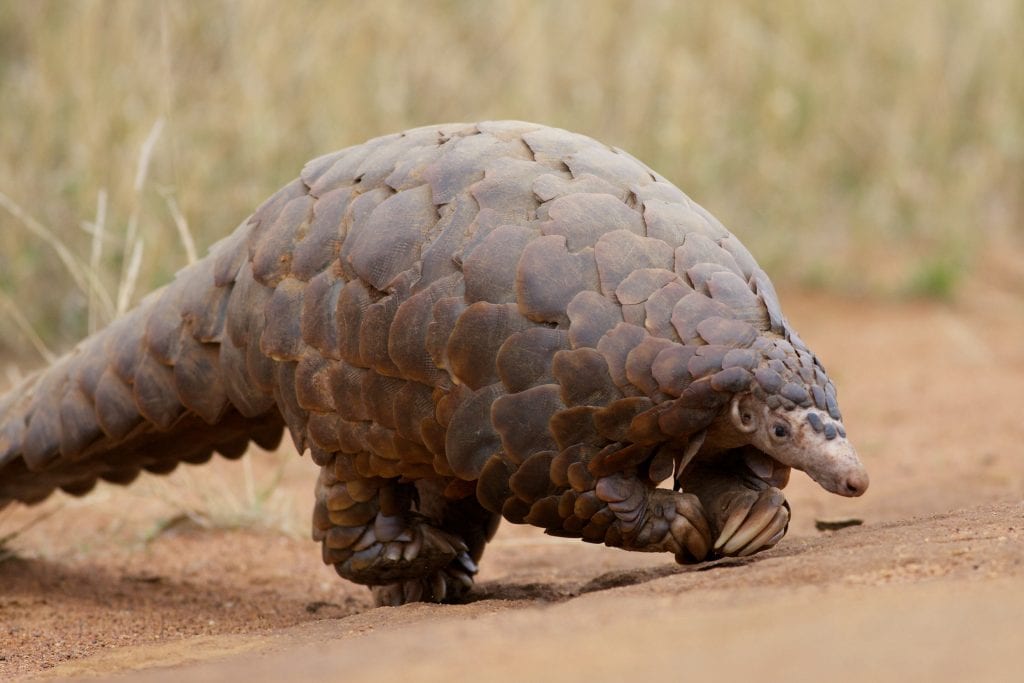
Stopping wildlife trafficking in its tracks

Key takeaways
- Wildlife trafficking is illegal — the shipment of smuggled animal parts, wildlife products from illegal sources or even live animals are no different to shipments of illegal weapons or drugs
- Wildlife trafficking is big business — criminals move contraband within countries and across borders, and the logistics industry can cut off this trade by seizing and stifling shipments
- Wildlife trafficking is a huge problem — Logistics companies have an opportunity to make a real difference and stop wildlife trafficking in its tracks
It took an x-ray to reveal the problem. When DHL took on the responsibility for screening packages passing through its service centers, senior manager Timothy Foote began to contemplate exactly what they should be targeting. “We were looking for illegal items such as guns, drugs and batteries” says Tim “but what about trafficked wildlife and products? There's really no difference between smuggling drugs and smuggling pangolins.”
While Asia holds a double-edged reputation for both its hugely diverse wildlife and illegal trafficking of them, the scope of the wildlife trade goes far beyond its borders. Illegal wildlife products pass through all major transport hubs around the world as a matter of course, meeting avid demand for animal parts, skins, medicinal ingredients, food products, souvenirs and even live animals.
“Asian countries are both a source of many of these animals and an often unwitting hub for their transportation,” says Foote. “As logistics operators, we have not only a responsibility but the power to stop this trade growing – but it’s not going to be an easy task.”
The illegal wildlife trade
Wildlife trafficking is the third-largest illegal trade in the world, superseded only by illegal weapons and drugs. Wildlife trafficking covers the more well-known items like elephant ivory or tiger skins, but also includes other mammals, birds, reptiles, insects and seafood as well as plants and timber. Some estimates suggest that seafood and timber make up the largest proportion of the trade, while relatively unknown mammals like the unassuming pangolin – the scales of which are highly sought in China and Vietnam for their alleged healing properties – can be found amongst the most illegally traded animals in Asia.
“Wildlife trafficking is a multi-billion-dollar business – and the key word here is business,” says Fiachra Kearney, CEO, Global Eye. “Even with the seizures and the low survival rates associated with the live wildlife trade, it’s still a profitable enterprise for traffickers.”
Global Eye combats trafficking and transnational crimes of many sorts, and the wildlife trade poses its own unique problems – most notably the sheer multitude of people involved in the different transactions, from organized crime syndicates to loose groupings of individuals. To disrupt their operations, the organization approaches traffickers as a complex network, but a network all the same: identify the nodes (whether groups or individuals), reveal vulnerable links, and target them with as many legal and regulatory mechanisms as possible. Global Eye’s research team picks the most effective tools of disruption based on in-depth examination of which laws and treaties apply, from customs breaches and fraud to wildlife legislation. Kearney also emphasizes the need for creativity in these approaches, and believes the private sector and particularly transnational logistics providers could be instrumental in defining and testing ways to stop traffickers.
Wildlife trafficking is a multi-billion-dollar business – and the key word here is business. Even with the seizures and the low survival rate of the live wildlife trade, it is still a profitable business for traffickers.
Tackling the problem
This multi-billion-dollar industry is further complicated with wildlife trade shifting from physical in-person transactions to e-commerce and now through social media, making it harder to monitor. Traffickers are also known to use an ever increasing number of code words in their online advertisements to refer to and sell the illegal wildlife goods, requiring extra effort to track, especially when combined with the clandestine networks trading through social media.
But no matter how these wildlife products are sold, traffickers need to move the illegal goods from place to place. That’s where logistics companies form an unwitting link in the chain – one which they have the power to break.
“Unknowingly transporting illegal goods brings additional risk and uncertainty to operations, along with huge potential to demolish brands,” says Foote. “But that also means we can, and should, play an active role in rendering the wildlife trade unprofitable for traffickers.”
Identifying the problem was the first step for DHL. Together with TRAFFIC, a wildlife trade monitoring network, they brought training workshops to DHL staff in Singapore. TRAFFIC investigates and analyzes the trends and impacts in the wildlife trade, encouraging government action to implement and enforce effective anti-trafficking policies and laws. TRAFFIC also provides information and advice to the private sector on effective approaches to ensure best practices.
“Companies are sometimes concerned that taking action could hinder their operations,” explains Dr. Yannick Kuehl, TRAFFIC’s Regional Director for East & South Asia. “Businesses need training tailored to their needs, so our focus is on helping integrate the right measures into their procedures for the staff.”
DHL’s workshops with TRAFFIC focused on building capacity and enabling better detection of packages containing illegal wildlife. Metal is easy to pick up on x-ray, but organic objects can be almost impossible to detect. To spot trafficked wildlife or animal parts, operators need to look for the shapes, training to spot suspicious outlines that could be a horn, bones or the skeleton of a live animal hidden in the package. The next step was updates in Standard Operating Procedures and the development of a guide to support employees to maintain the security and integrity of shipments that travel through DHL’s network, ultimately helping to prevent the illegal wildlife trade. In trafficking hot-spots like Cambodia, DHL employees have begun to profile shippers and maintain direct communications channels with local police so that any illicit shipments can be seized and acted on as quickly as possible.
There's really no difference between smuggling drugs and smuggling pangolins.
“We are now more focused on security and protection, and building greater consistency across the entire business,” says Foote. “We’ve built knowledge on how to identify wildlife trafficking, and work with the relevant customs and law authorities when they require us to get the evidence they need to prosecute.”
But this is not where it ends. The key challenge is to understand how the traffickers are misusing the services of the logistics companies, and put measures in place to combat this abuse.
Taking it further
“Often the first step for a company is identifying the operations at a higher risk of being abused by the criminals,” says Kearney of Global Eye. “This could be through creating a corruption map and identifying locations more likely to be a sending or receiving point for trafficked wildlife and concentrating the anti-trafficking efforts there.”
Understanding the problem can also open up new solutions. From Kearney’s experience, traffickers normally take one of two approaches: chance or planning. Traffickers have been known to opt for a ‘chance’ approach where packages are sent with little preparation but higher odds of confiscation, loss and death. Other traffickers choose to invest in securing safer ‘planned’ trade routes, often with inside help at the logistics companies to check in the illegal products and move them into the system smoothly.
Knowing this means companies can tackle the problem through a clear recruitment policy and training. “Insider activity can potentially corrupt logistics operations, so it makes sense for companies to invest in a legally-binding code of conduct that addresses the issue of wildlife trafficking and corruption, or whistle-blowing policies and helplines to report any suspect activities,” explains Kearney.
Wildlife trafficking is a complex issue that needs to be addressed from all sides to break the chain. It is the demand for these products that fuels this trade, and without this demand the networks would collapse. Logistics companies can directly influence the transportation link, but are also in a strong position to affect demand as well.
“Logistics companies are the unintentional connection to the people buying these products,” says Dr. Kuehl of TRAFFIC. “Through this very customer relationship, they can raise awareness: telling customers that what they are buying is illegal. It is all about awareness, telling the consumers why.”
“It’s these insights from bodies like TRAFFIC and Global Eye that need to feed how the logistics sector deals with the wildlife trade,” says Foote. “Otherwise we’re hunting in the dark.”
Working together
The illegal wildlife trade will take more than just good intentions to crack, even with more and more businesses on board. When one company makes a move to close-off a trade route, traffickers look to other options and unknowing providers. “None of us can do this alone,” says Foote. “It’ll take an industry-wide effort to shut down the transport networks that traffickers rely on.”
In December 2014 DHL was one of the first companies to sign-up to the United for Wildlife Transport Taskforce. This taskforce brings together the transport industry, conservation leaders, and policy experts to identify ways the illegal wildlife trade uses logistics services to transport products, and how the industry can break links between buyers and sellers. The taskforce’s 40 members include some of the biggest names in the industry including the International Air Transport Association (IATA), China Post Group Corporation and the International Maritime Organization (IMO).
On the 15th of March 2016 DHL Express UK & Ireland signed a declaration at Buckingham Palace, committing to help support the Private Sector in fighting the illegal wildlife trade along with 60 other organizations. Later in 2016, DHL decided to leverage the partnership with United for Wildlife company-wide. The Agreement focuses on increasing awareness to identify illegal wildlife trafficking, sharing information on high risk routes and transport methods, developing secure systems to share information with law enforcement and customs authorities and notifying authorities of suspect shipments and where possible refusing to accept or carry them.
Where next?
The logistics industry can play a big part in disrupting and cutting off the global transportation of illegal wildlife products. But the trafficking chain is made up of many links, and the demand for these products also has to be challenged to finally close down the trade in illegal wildlife. “Ultimately this will only be achieved through awareness and behavior change” says Dr. Kuehl, “and a big part of this is continuing the conversation and working together with partners across sectors to make wildlife trafficking a thing of the past and protect the world’s most vulnerable species.”
ALSO WORTH READING












 English
English